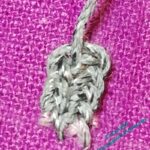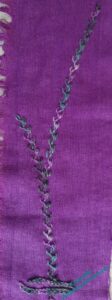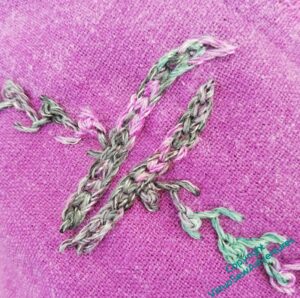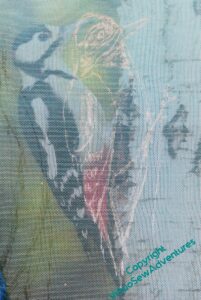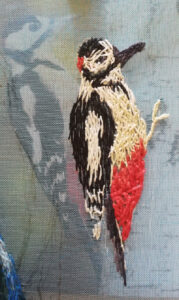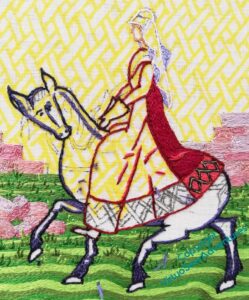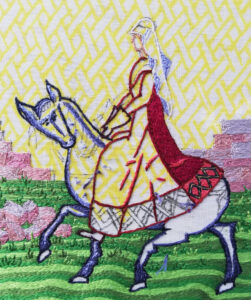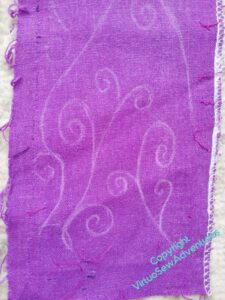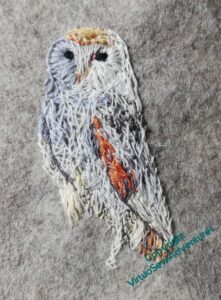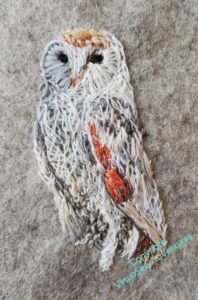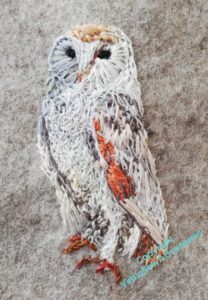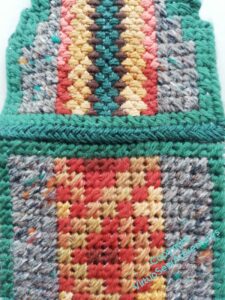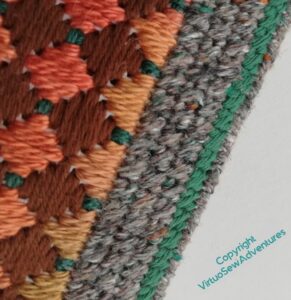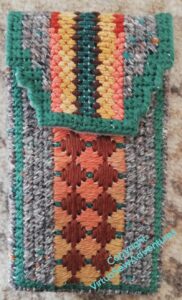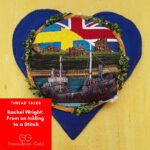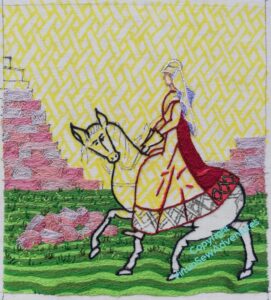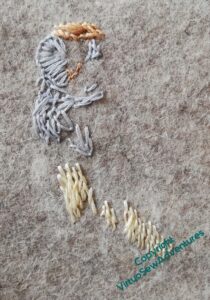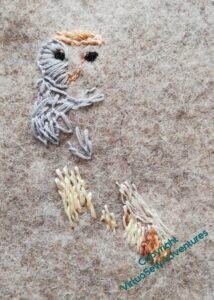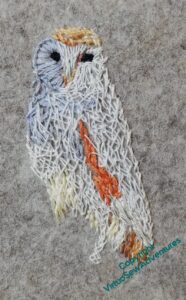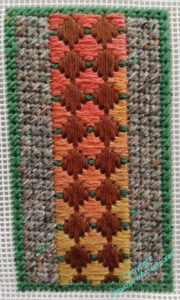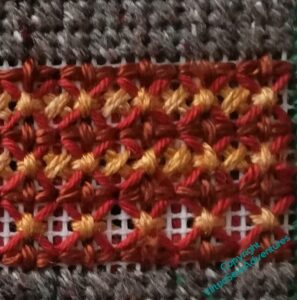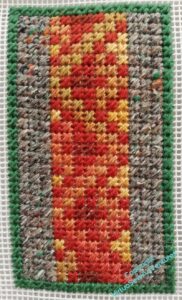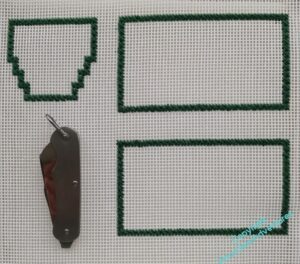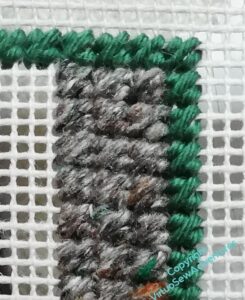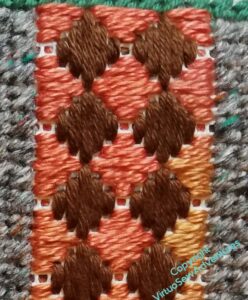Category: General Embroidery
Another purple bag…
I thought I rather fancied tackling plaited braid stitch again, using the same variegated thread as for the chain stitch fernery. However, when I gave it a go, it turned out to be a poor thread for the stitch – too floppy, and too easily pierced. It’s not obvious, but there’s a glitter thread running through it, which interferes with the cohesion of the strands. Oh well, I’ll find somewhere else for the plaited braid stitch!
After some thought, I had a go at Mountmellick Thorn stitch.
That’s better. And this one isn’t going to be an all-over pattern like the fernery. Instead,I’ve done two vaguely treelike shapes, back to back, with Hungarian Braided Chain (I’ll get a braid in there somewhere!) providing the ground level.
Then I felt that maybe it would be useful to work the same Mountmellick Thorn stitch but at different proportions, so that I have a comparison. That’s in progress.
I’m also trying to work out how to line and assemble them neatly. I’m intending to use my little hand cranked Jones sewing machine, but as I’ve managed to bruise a couple of ribs and interfere with picking up that sort of awkward and heavy weight, I’m a bit unwilling to promise a prompt finish here!
There’s going to be a woodpecker, too..
I am going to start rereading the book again, at some point soon, but in the meantime, since I’ve rediscovered my “Vision of Placidus” notebook, I know that one of the birds I was going to include is a woodpecker.
I’m going to have to go to the shops and find some more gauze soon, as well, but while I can squeeze an animal in to the existing fabrics, I will do so.
I’ve commented before, I think, that getting a readable and workable design drawing onto gauze is a non-trivial exercise, but this opaque white line (a Posca pen) is pretty much the best I’ve found so far, and it also allows me to help myself by putting a few extra emphases on the lightest parts.
It’s amazing how quickly these little animals go, once I have a chance to get started. In fact, I was so entranced by how Woody was growing that I didn’t stop to take photos. In fact, I barely stopped to draw breath.
So this photograph shows a single afternoon’s work. I’ve used mostly fine silk threads, although his red breeches are a soft perle, and some of the white is probably cotton. As for approach – I simply tangle my stitches together, feather stitch variations, Cretan stitch variations, the occasional chain stitch or straight stitch. What I’m hoping is that the tangle of stitches will create a subtle variation in colour that will help the whole thing feel alive when it’s viewed from a reasonable distance.
I didn’t have much I wanted to add, in the end. A few highlights, filling in the wings a little, and then really the woodpecker is done. I may add more when it comes to assembling the piece (remember all those seed stitches I added to the View of the Excavation once I started assembling the Dreams of Amarna panels?), but that can wait until I know what is being balanced with what.
I have been thinking, on and off, since I was asked about it after my talk, that assembling Placidus may prove to be an exceptionally challenging process. The panel I envisage is going to be about five foot by four foot, and I have a horrible feeling I’m going to be propping it against a wall or slinging it from hooks or even emulating one or other of the great Impressionists by somehow arranging a slot in the floor to drop it into while I tackle the top.
Maybe I shouldn’t be in too much of a hurry to finish this one…!
Aethelflaed’s Horse
Now the thing about Opus Anglicanum is that it’s lots of very small stitches, so you maybe don’t see so much of Aethelflaed, but apart from occasional periods of Life getting in the way, she is making progress.
I’ve started on her horse. It’s going to be a grey – what you see of it, what with her riding dress and all! – so with a wave of my artistic licence, shadows and details are going blue.
I have time to wonder what she’d call her horse – all the names I can come up with tend towards the Norman French (Blanchemain, Blanchefleur), and that’s a good couple of centuries too early. So I’m looking for something Brythonnic, or Welsh (although the Mercians weren’t on reliably good terms with the Welsh, so maybe not..). Welsh would suggest something with “gwyn” in (for “white). Moving to Old English, “hwita” is “white”, but “aedre” is “stream”, and then suddenly you have a name starting with the same syllable as the rider’s. And that is the sort of thing you find in retellings of myths as a way to bring the two close together in the mind.
Thoughts, anyone?
Un-idling My Hands
I would like to have a small pencil bag to take sketching, and I’ve been finding myself in the evening, fidgeting because I can’t concentrate on the complicated stuff and my crochet has fallen so far out of my head that I am contemplating pulling the whole lot out (most of one sock, from rib to the beginning of the toe) and starting again.
And yet I would like my hands not to be idle.
I’ve just taken a pair of side panels out of a skirt, so I’ve pressed one of those panels and drawn some rough fernlike curlicue things on the fabric in chalk – just freehand, nothing complex, no attempt at evenness, just a sense of balance and an all over pattern.
Then I went rummaging for a thread that would live happily on the fabric. This is quite a heavy thread on a cardboard spool, and I’ve not the vaguest idea where it came from. It varies from a very dark teal to a lighter version of the purple of the fabric, and it’s going well so far.
Strictly speaking that thread is on the heavy side for the fabric, and I may find that coming back to bite me, but for now, my little homage to the “Fernmania” that brought you the scrolls on custard creams is going well.
When I’ve done the whole length I will need to decide, do I line it with the other side panel or save that to make another bag with? Little drawstring bags are always useful, after all….
Finishing The Penknife Case
The penknife case came together fairly well in the end.
Some years ago I settled on a satisfactory way of joining two canvas pieces at an edge. It’s a sort of long armed cross stitch, which goes into each hole twice. That means it’s fairly secure, but doesn’t take security to excess, and it’s easy to do, even when I’m a bit weary.
I used the dark green thread I used on the front for the cross stitches, and I think the top, “hinge” seam has turned out well, if a little stiff.
For the side seams, having run out of the green, I used the grey mottled thread.
That was a bit more of a challenge. I didn’t quite have to heave the needle through with pliers, but it was, nevertheless, quite an effort at time.
I don’t think this seam is going anywhere in a hurry!
However, it’s all nicely finished and secure now, and I didn’t buy any thread at all for it. Or canvas. Or felt to line it with.
Given how often avowedly “Stash Busting” projects turn into “Stash Growing” projects, I am going to take that as a significant win!
I believe that by now, anyone who signed up for my talk a couple of weeks ago should have received access to the recording.
Thank you to those who were there at the time, and thank you for the kind comments I’ve received. Please do ask more questions if they occur to you!
I’ve not forgotten Aethelflaed…
… although I will admit that sometimes I don’t manage to fight away all the things that get between me and my frame at a time of day when I have any chance of stitching her sensibly!
However – I’ve done the grass!
Well, I stopped doing tussocks when I thought I might want to do more extensive tussocks in the foreground, and decided to do the horse first, in case I wanted seedheads nodding over its legs. But apart from the tussocks, the grass is done.
However, that means I now have a decision to make…
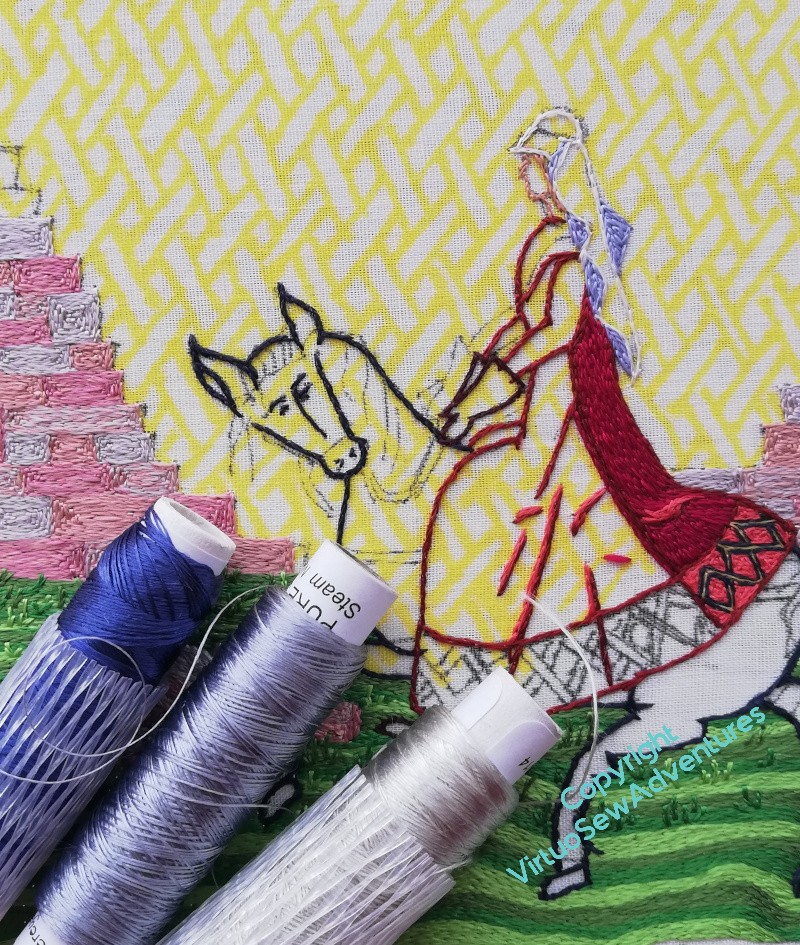
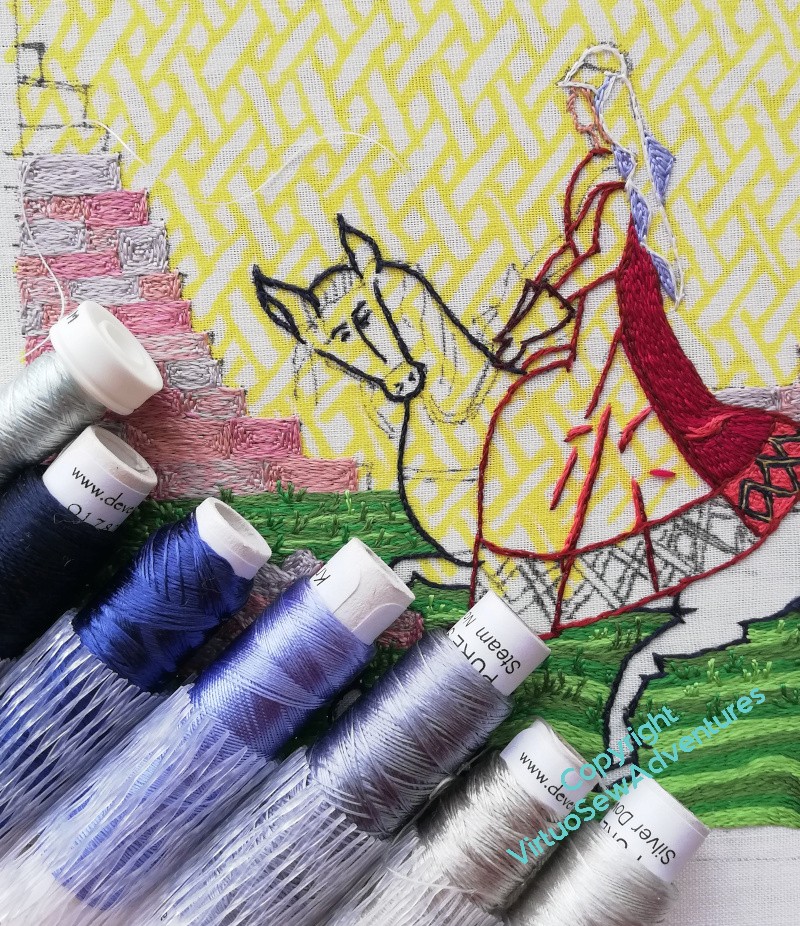
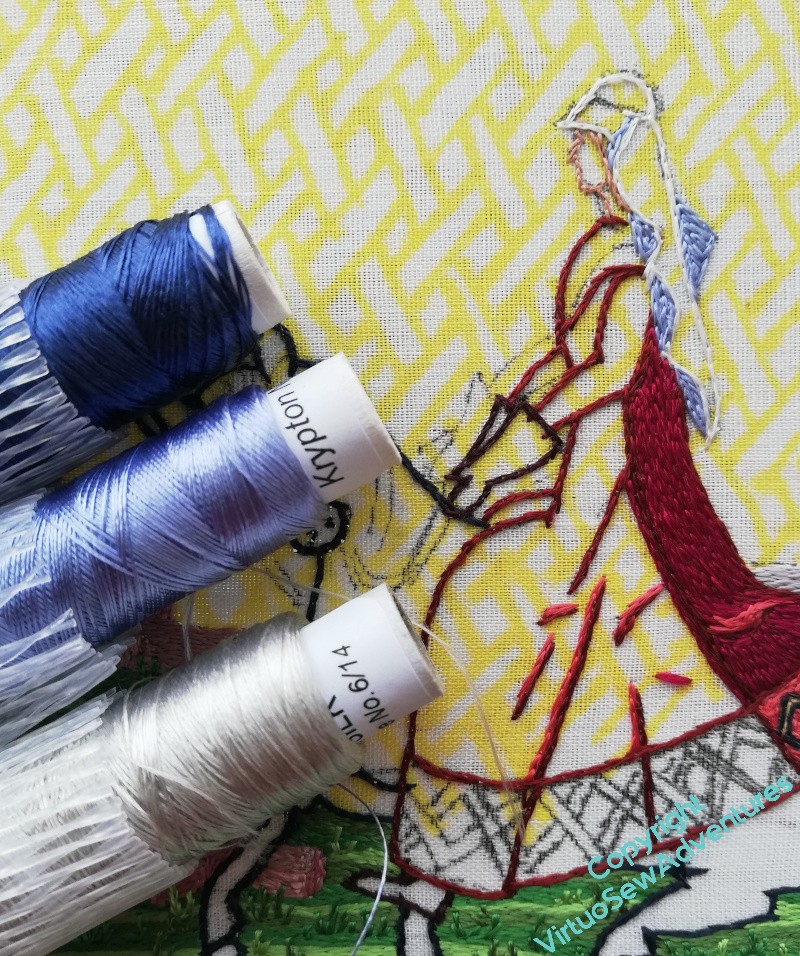
I’ve decided she’ll be mounted on a grey (contrasting with William The Marshall’s chestnut), and that it will be grey tending to blue. But which blue, and how much blue, and what colour should the lightest shade be? This is going to be important, as I think I’m not going to do dapples this time, just shading and a smooth coat.
Some thinking required…
More on the Canvaswork Penknife case
When you last saw this panel, there were gaps. They’ve now been filled with green cross stitches.
Yes, that works, I like the way the Caron Collection Watercolours thread runs from yellow to orange, the brown provides a bit of stability, and the green ties the inside and outside together. . It’s not the stitch pattern I was aiming for (I’m not sure what went wrong), but I like it.
However, that was, if I am honest, the last easy thing about this canvaswork!
I wanted to put a different stitch on the back, maybe more hardwearing, because I was considering using the finished object on belt loops. This, however, isn’t it.
Again, somewhere along the line it’s not the stitch pattern I was aiming for, and I’m not sure quite what happened. Suffice it that reading charts and diagrams seems to be a somewhat episodic skill for me, and I am at present in an “Off” period!
Furthermore, the coverage I want is requiring too many passes, too much tangling, and looking altogether too busy. Out it comes!
In the end, I went back to Mosaic Stitch.
It is built up in a rather haphazard fashion of zigzags, starting with two rows in the Watercolours thread, again, then moving outward with soft cotton in two shades of brown and adding a few details in a goldeny mustardy pearl type thread that I think is absolutely gorgeous. Unfortunately I’ve not the vaguest idea where I got it from, or when. It might even be silk – and here’s me putting it on a cover for a penknife!
Oh well, better to enjoy using it than have it sitting in a box asking me When it will Get A Chance To Play!
Now – a very exciting thing! – I shall be giving a talk for the Embroiderers Guild on June 3!
I believe I’ve turned this image into a link to the Eventbrite page, and for anyone not in the right timezone, or otherwise occupied on the day of the talk, the Guild makes recordings available for some time afterwards.
I shall remind you every week until it happens!
Penknife Case In Canvaswork
I’ve decided this penknife needs a case. (Of Course I Have!).
Canvaswork is often a good choice for this sort of thing, and I’m going to try to keep to stash. That may make things a bit harder, because my canvas is not especially fine, and as it turns out I don’t have much that’s suitable for that count of canvas.
I have prior experience of making something that ended up too small to do the job, so this looks very much too big. By the time it’s done, it might be the right size, but if it’s too big, even with padding and lining, I’ll simply start again, and use this for something else!
I actually started with the grey flecked yarn. It has flecks of green, and a browny-orangey colour, so I thought that might make an interesting challenge to combine. The panels are outlined in Mosaic Stitch, using a soft cotton in a green that goes with the green flecks. The grey had to be used double, so I think this is going to be quite a close run thing to get to the end with enough yarn to do the job!
The next panel started as Pavillion Steps, from Jo Ippolito Christensen, but I couldn’t quite make sense of the diagram, so it’s become something much simpler. Caron Collection (Wildflowers, I think) in one direction, soft cotton in the other, both of them used double to achieve reasonable coverage.
It’s clear I need to fill in that gap with Something, so now I need to rootle around in the stash to find something suitable. Several somethings suitable, in fact, as I don’t think the remaining stock of these threads will be enough for the rest of the case. I can do more Mosic stitch on the back, perhaps, but making sense of the top flap if I can’t run the same pattern across it is going to take a bit of thinking about.
Now – a very exciting thing! – I shall be giving a talk for the Embroiderers Guild on June 3!
I believe I’ve turned this image into a link to the Eventbrite page, and for anyone not in the right timezone, or otherwise occupied on the day of the talk, the Guild makes recordings available for some time afterwards.
I shall remind you every week until it happens!

